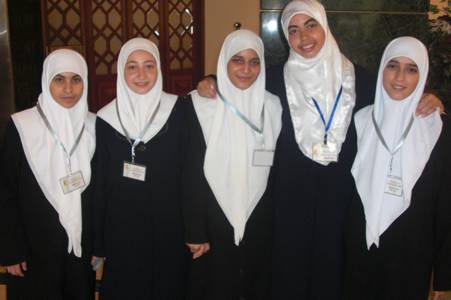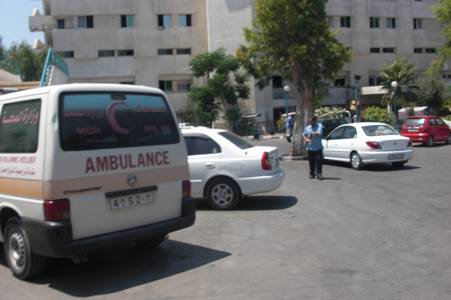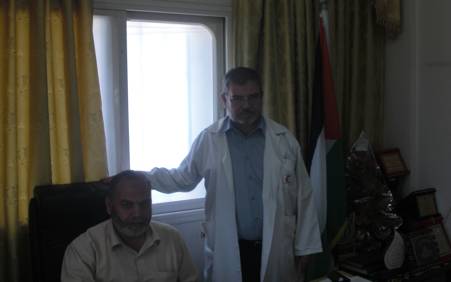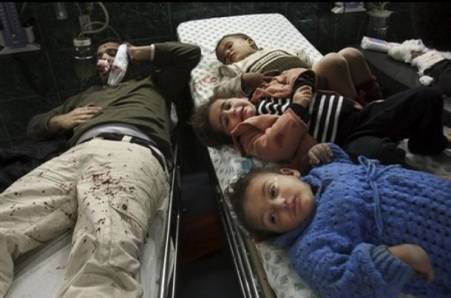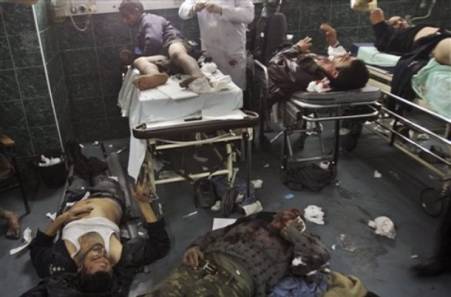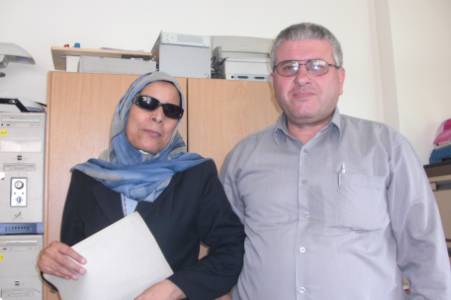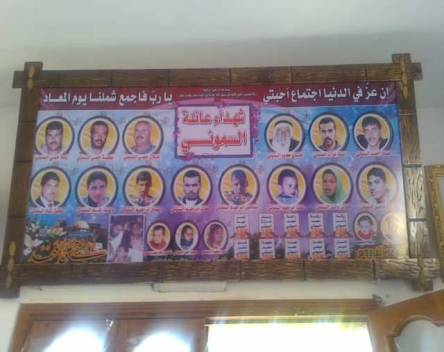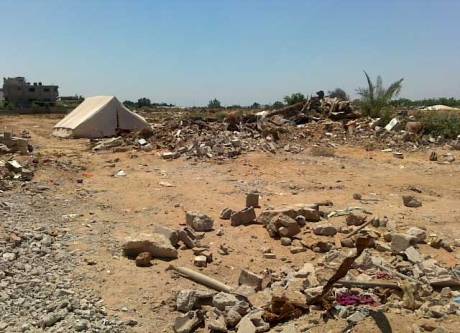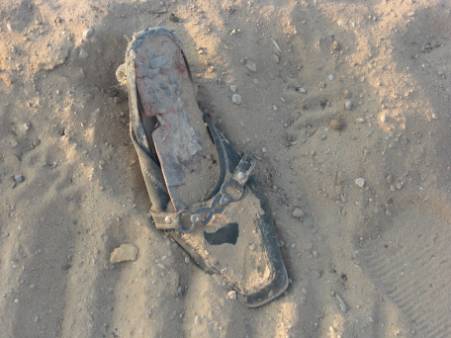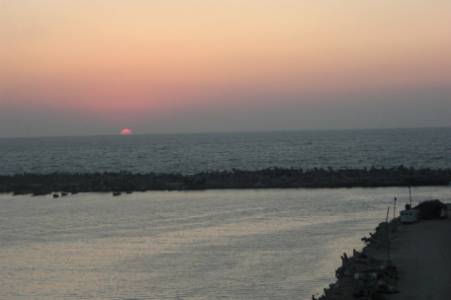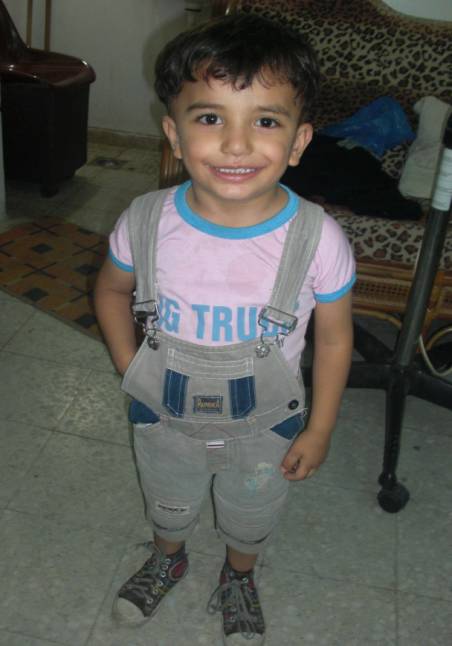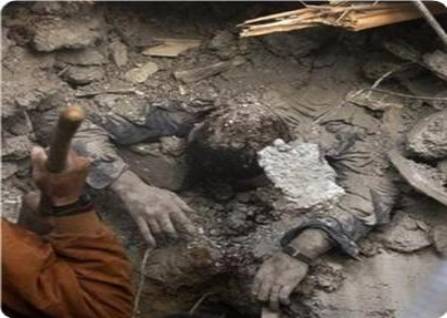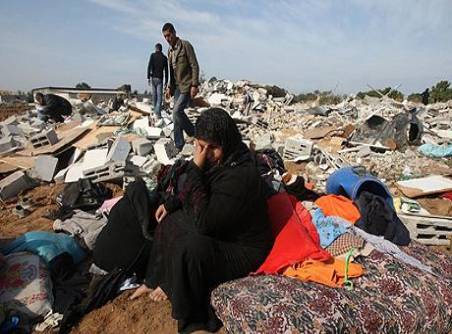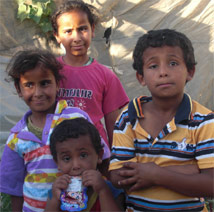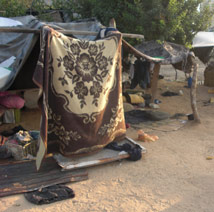


Tuesday’s Child Blog Tuesday’s Child Returns to Gaza – Day 10 Wednesday 15th July 2009 The hotel is buzzing this morning as there is a Conference on for women bereaved in the war. I prepare the toys and sweets for our visit to Shifa hospital and bring them down to the foyer. A group of young women stop to talk and ask me where I am from. They explain they are here with their teacher for today’s conference. UNRWA are also represented here today. I chat to the young girls and ask them what they are studying and about their career aspirations. I also take a photo and they are delighted to have a digital picture of their group and I promise to send it on by email. Haab would like to be a doctor, Esraa, a chemical engineer, Maram, a university academic and lecturer, Latiaf, a business woman and Wala, a science teacher. They are a very vibrant and dynamic group.
I ask about their experiences of the war. All of their families are safe but in each case, their home is badly damaged. They speak of the sheer terror of the war, the constant and relentless bombing, the lack of food and water and the exhaustion and bewilderment of the people. I ask about their hopes for the future and again, world travel features and freedom, the right to make independent choices and, first and foremost, unity in Palestine and an immediate end to the blockade. A very insightful group of young women. I wish them well in their studies and their future careers. We arrive at Shifa hospital at 10 a.m. Photographs of Shifa hospital are not permitted here of but I take one anyway. We are welcomed by the Medical Director Dr Mohammed Kuzedt. Shifa is by far the largest hospital in Gaza and received the majority of the acute admissions during the war. In terms of infants and children, the hospital has a neonatal unit and a paediatric surgery department. Dr Kuzedt thanks us for our interest in the hospital and the gifts for children.
I ask Dr Kuzedt to describe Shifa hospital during Operation Cast Lead and the response of the hospital and staff to the crisis. “In the first 10 minutes of the war, 60 bombs and rockets were dropped by air assault as well as shelling from the sea. In the first 30 minutes, a total of 250 attacks and an estimated 100 tonnes of bombs in the first day alone. The hospital received 500 admissions in the first 30 minutes, dead and alive. We did not have the ambulances to cope and people came to us every way imaginable. The ambulances in service entered the area piled with bodies. Throughout the day and many days to follow, the floor of the emergency room was flooded with blood. Not one cm of floor was uncovered and it was like working in a river of blood. The human suffering was extreme and everyone, staff included, were in shock. I am a medical cardiologist and became a surgeon overnight. The injuries were horrific. One family of 5 who came in on the first day, were burnt black, incinerated. As the war continued, large numbers of dead bodies came in from single families. The Samouni family in particular stand out in my mind – 26 dead bodies in a terrible condition, some shot, some decapitated, some churned up by tanks, some burnt, came in on one afternoon. For me, this was one of the most horrific memories. The onslaught was relentless, we were under attack by F16s, apaches, helicopters, warships and discovery technology relentlessly”. Dr Kuzedt continues, “In terms of management of children, this is the paediatric surgery centre and almost all child trauma cases came here for surgery. Many children were already dead on arrival. My God, the number of children that came to us dead was shocking. Many were badly burned, many dismembered. Also, many were shot at close range, clearly direct assassinations. This was not a war, it was not about Hamas, this was a civilian massacre and most of all, it was a slaughter of innocent children. Many babies were killed when they were being breast-fed. Many. Also mothers were killed who were breast-feeding infants. In terms of injuries, they were all acute trauma and the most difficult to manage were the burns. We have treated burns many times but we have never had to treat white phosphorus burns. To use such a chemical is too cruel for words”. “Our staff were exceptional. The hospital became their home for 27 days and they worked triple time. It was difficult working under such extreme conditions and all the adjacent buildings to us were bombed. We lost hospital workers. One case, was particularly tragic. A young technician wanted to go home for a break and check on his family. His father arranged to pick him up outside the hospital. He left at midnight and as he was waiting for his lift, he was killed when the nearby mosque was bombed within minutes of him leaving the hospital. His father arrived to take his son home and he was dead. This case stands out in my mind. Many people were killed in this bomb. The force of it shook the whole hospital and broke many windows. Even the monitors jumped. People were found 4 floors up from the ground level of the mosque and many impaled to the ceiling, it was horrific. All hospitals in Gaza were bombed, not just Shifa. There was no regard for human life here, well any form of life; even cows, sheep, goats and donkeys were slaughtered – shot or burnt or mowed down by tanks”.
“The death toll is much higher than reported figures. We estimate 2000 deaths and 5000 injured, of which 2000 critically injured. Of the deaths, 800 were children and a one third of all deaths in children and adults were female. I must also acknowledge the Minister. He was with us here in Shifa 24/7 with the people”. I sit and listen to the horror and the pain and suffering that this hospital experienced and as he speaks of the river of blood and the many assassinated children the tears flow unashamedly. No hospital emergency or contingency plan could manage this level of trauma. I try and think of former hospitals I have worked in, even large hospitals like St George’s in London and how they, with all their resources, and not in a state of war, struggled to cope with smaller scale disasters such as the Clapham rail disaster. Shifa must have been hell on earth. I read one report from a medical volunteer in The Guardian, at the time, horrific. I wished at the time that I could’ve been here to help. Dr Kuzedt hands me his mobile phone and on it a picture of his son Mohammed, who died in the war. He was 21 yrs old. I give him my condolences, this physician turned surgeon overnight, who must have worked so hard to save so many lives and lost his own son in the process. I ask how he died, he does not answer but gives thanks to God for his life and that he died defending his country.
Dr Kuzedt thanks us for coming and our interest and support and arranges for a person from PR to escort us around the hospital. “Even your visit is of great support to us. We know that Ireland has great empathy for the people of Gaza and we thank you for your consideration for our children”.With that we end our meeting and the hospital tour begins. We are escorted through the large admissions area and emergency room and to the paediatric department. As we walk along the corridor I notice the sign for the burns unit where Dr Khan and his team were hoping to be in February. How their expertise could’ve helped so many and again I reflect on their disappointment at Rafah. Thankfully, their trip was not in vain as they were able to lend their expertise to the badly injured transferred to the Palestinian hospital in Cairo and hopefully at least some of the many supplies they brought with them made it through to Shifa. I joined Dr Khan’s round on the first day. I have worked with many consultants on clinical attachments in my time, and while I was not part of Dr Khan’s team, he was exceptional. Quite brilliant and it was a privilege to observe him at work. We wait outside the paediatric unit here for some 20 minutes as the paediatric surgeons are all praying. Again, the faith of the many of the people here is commendable. God and the hope of peace seems central to their daily lives. I am welcomed by the Head of Paediatric Surgery, Dr Kuzedtz, who is also fluent in English. He thanks me for the gifts for the children. The department first opened in 1990 and the majority of patients admitted here are between 0-12 yrs. Many routine cases here are congenital abnormalities and hereditary diseases resulting from close inter-marriage. He speaks of the unit during the war. “In terms of total admissions to Shifa, 40 – 50 percent were children under 12 yrs old. Specialist surgeons became generalists overnight and everyone helped where they could. Surgery was difficult under the constant bombing and the lack of equipment, facilities and essentials like blood made the situation much more difficult. In the first 30 minutes of the war, we had 56 paediatric admissions to this unit and probably, as many again, if not more, were dead on arrival to the hospital. The first day was the worst in terms of fatalities and injuries. Surgical procedures for children were mainly head injuries, occlusions, burns and sadly many amputations. I, nor any of my colleagues have ever had to deal with trauma on this scale. It was horrific. Many children have long-term complications and there is huge need still for trauma counselling. Other children were transferred to other countries for treatment – Egypt, Jordan, Lebanon mainly. All of the children affected by war have been discharged now. Some are still in the Rafah Centre for rehabilitation and if you have time you should visit there”. I thank him for his time and we start our tour of the beds. Many of the children here are very sick. Many I note have hyrdocephalus. I have never witnessed so many babies with congenital malformations in one place. It is quite shocking. More education is needed about the risks of close inter-marriage. We give out toys and, to those who are able, also sweets. Also, again, nurses and allied staff ask for toys for their children. The wards in the unit here are very basic, the hospital is clearly under-funded and again there is no evidence that this is a paediatric unit. There is no infection control as we know it at home although hospital staff are mopping wards as we walk around. We walk some distance to visit the neonatal unit. I am looking forward to seeing it but the consultant here does not permit us to enter. It is a pity as I was keen to see it and assess their needs. Next time hopefully. From Shifa, we travel to a blind school in the same area. We have received many calls from the school this morning to visit them before we leave Gaza. No time like the present so we stop and vist. We are met by the two directors, of the school, one of who herself is blind. They are urgently in need of Braille paper and they are unable to get this through the blockade. They have asked for paper many times but it is refused and they have asked many organisations to assist them with little joy. I had heard last year that batteries for children’s hearing aids for the deaf school were refused access and now Braille paper for blind children. My goodness, again, I am struck by the pettiness of these people who call consider themselves civilised. I wonder what Christ would make of it? I hope, when He comes, a second time, He will come to the deaf and blind children of Gaza first. The children have already left for the day. I ask if they have many new children since the war and yes they speak of many children who lost their sight during the war. They speak of one boy in particular from Northern Gaza who lost both his eyes and is struggling to adapt to a life of blindness. They ask me to come back and meet the children tomorrow. I explain I cannot but hopefully on our next visit. The offer to leave a CD of their work into my hotel. I promise to look at it and do my best to help with Braille paper. Again, the problem, as always for us, is access for materials.
This afternoon, I ask to visit the Zeitoun area of Gaza city. Here on Sunday 4th January, 50 members of the one extended family, the El Samouni family were rounded up. This family, citizens not refugees, survived the greatest loss of life in the war and the Red Cross described it as “a shocking incident”. It received a lot of press coverage at the time and yet I was keen to visit it and pay my respects to those who lost their lives here. The Samounis were a very poor family, all farriers, living in 12 makeshift homes in this area. Israeli soldiers knocked on one of the homes, asking for the father of the house, he came out and they shot him dead in front of his family. On the following morning of Monday 5th January, all of the Samounis were rounded up into Wa’el Smaouni’s house. Many were shot directly in front of each other and the house was continuously shelled with the dead and injured buried in the rubble. The Red Cross was refused access and ambulances could not get to the area for 4 days. The first help to this home came by foot, by which time 29 people were dead, the rest injured. Some died from shells, some from direct shooting, other bodies torn up by tanks. As I walk around the area, there is nothing left, here. There is no evidence now of this massacre, only a solitary shoe in the rubble. All of the dead were civilians. Many of the injured are still to traumatised to speak of the atrocity. Those who have spoken, said apart from the pain and the bleeding and the sheer terror, they were starving as there was no food in the home. Two of the surviving children were treated in the paediatric surgery department in Shifa we visited earlier today. The family are not here at the moment, we will call back again.
I am told of another family also, in Zeitoun, the Al Dayah family, who lost 22 members including 12 children and a pregnant woman. Only two brothers survived this attack. In this household, Israeli forces entered and shot some of the family dead. They then ordered the rest of the family to evacuate. They refused saying there was fighting all around and they would be killed and begged mercy most of all for the children and babies. They were assured they would not be hurt and the children would come to no harm. They were marched 500 metres along the road behind soldiers. The soldiers walked to both sides of the road and the order was given to open fire on the family. Again, here many of them bled to death from their wounds as emergency services could not access the area. Again, all of the dead, were civilians, ordinary people, hungry people, trying to make something for their children out of nothing. It is one horror story after another, and despite, after even all of this, the world permits this blockade to continue. All of humanity should be deeply ashamed for not speaking out louder and saying END THE BLOCKADE. I feel sick, nauseated to the pit of my stomach by what happened here. I return to the hotel, to take a shower and there is no water. The heat is stifling and clinging. I cannot get the horror of Zeitoun out of my head, now thumping. I am outraged at all I have heard to day, both in Shifa, at the blind school and in Zeitoun. I look out at the sun setting and wonder why such a small place has had to endure so much bloodshed and sheer cruelty and wish they could all be transported to a happier land.
Sabah, phones and asks me how the day went. I have no words, only tears. I drive over to see her and we talk. I ask more about the El Samouni family and she says she will send me pictures. Ayia, Sabah’s daughter takes me round the corner to a hair salon. I laugh as I have a thing about having clean hair and, with no hot water, or even no water, on many occasion, it is very welcome. And hot water, heaven and a head massage, nirvana. We sit in the salon and I speak to the women working here of the war. The lady drying my hair tells me of the horror. Also, of her little boy, who is still in shock and does not speak, he has a constant stutter and is now mostly silent. That was the greatest shock for me the weeks of the war and after, the shock of many children, all so silent. She asks if I can help her little boy, I explain I can’t, but often with these things and with as much normality as possible, he should come round and start to speak with his brothers and sisters again, but not to force him to speak. I have toys and sweets with me, in my bag, always a supply on had. As she drys my hair, the electricity fails 6 times. I tell her it doesn’t matter, I am just happy that it is clean. I think of the large salons at home, and what they and their clients would make of this. On the sixth failure however, she insists in wheeling her generator out onto the street. I don’t know, or want to know, what she has plugged it into, but again we have light and she drys off my hair. And then her sister arrives, with her little boy, Mamoud, who does not speak. I sit him on my knee and give him a toy and he laughs and giggles. We sing a song and he joins in for a few words, but after still, nothing. At least there are smiles. I pray that he will find his voice again in time.
I return to Sabah’s house. The days are going so quickly now and we still have so much to do. It is hard to believe I have been here 10 days already. Tomorrow afternoon, she will take me to meet new families, not yet part of our feeding programme, who are in need of help and support. Tomorrow morning I am back with UNRWA. The internet is working tonight when I get back to my hotel! Good to have it back. In my email, many good wishes from home and then some library pictures from the El Samouni massacre of Zeitoun. I open, in disbelief and fill with sadness. Also, a link to the latest report from the Palestinian Centre for Human Rights here entitled War Crimes against Children (www.pchrgaza.org) that includes a report on the Al Dayah family, among many other shattered families, whose losses must be just too painful to bear. Shocking reading and viewing and made all the worse by being in this place earlier this afternoon.
I open direction for our times tonight at heaven speaks to those who are experiencing tragedy and I read “My beloved child, I grasp the depth of your pain. I will walk you through each moment of anguish, surrounding you with heaven’s graces. No. You will not be left alone to walk through this tragedy” and later again the following words from Our Lady, or Miriam as she is known by the Muslim faith, ” My poor little child how you suffer. There are times when suffering is so great that a little one cannot even feel the comfort that is lavished upon them. It is this way for you now. In your grief you stagger but you are supported. Your pain will not be without value....I am with you little dove. Your pain will not be without value and every tear that you cry will be a tear that is noticed by heaven. Peace now as we walk you through this time of grief”. As I read these words, it is clear that the poor little child to which they refer, is Gaza itself, for in its smallness, just 25 miles long, it is a child among much the bigger countries and continents who should know better. If you are in a position to help any of the families we met during our time in Gaza, please contact us at info@tuesdayschild.co.uk or donate online here » |
||||
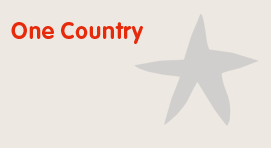 |
Country Spotlight: Palestine/Israel ... Oh little town of Bethlehem…. The ongoing conflict in the Middle East continues to cause human misery and suffering, especially for little children. Tuesday’s Child is fundraising to support a number of projects in Palestine/Israel - Gaza, Bethlehem, Ain Karem and Bethany, all co-ordinated by the daughters of charity. In war torn Gaza, the muslim children are starving. Fifty of the poorest families, receive a weekly food parcel of dried foods. These parcels are given out through the nursery schools in the area. In Ain Karem, a centre for 60 children with severe disabilities, from the ages of 5 – 22 yrs, the need here is basic but essential – diapers for the children, all of whom are incontinent. In Bethany, a girls school needs a new school bus to transport them safely to school. The Holy Family Children’s Home in Bethlehem is a crèche looking after 110 children, 1 – 6 yrs old either orphans or children from the poorest of the poor families. Find out more about the Countries we help... |
Tel: +44 (0)289 050 2725 | Mobile: +44 (0) 7545 452362 | Email: info@tuesdayschild.org.uk | Terms
